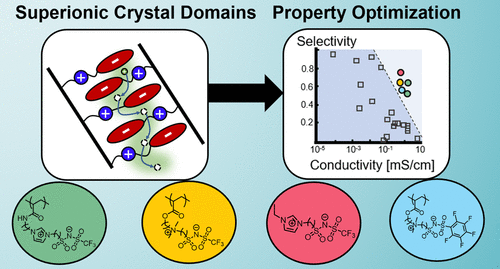energy materials
Mixed ion-electron conduction
Mixed conducting polymers conduct both ions and electrons. Developing the relevant design parameters for optimal conduction of both charged species in a single system is a non-trivial task. Traditionally, these properties have been studied in separate materials classes, making the rational integration of both properties an interesting challenge. For example, many conjugated polymers have the ability to transport ions and electrons, but optimization typically focuses on semiconductor doping for electron transport, while ion transport optimization has been the focus of polyelectrolyte research. Additionally, these charged species follow different transport mechanisms across a variety of length scales as shown below, with electron conduction typically favoring crystalline regimes with long range order, and ion conduction favoring amorphous regimes.
We are interested in understanding how the structure on different length scales affects both ion and electron transport in polymeric materials.
Mixed conducting polymers have applications spanning areas from energy technology to bioelectronics, including organic photovoltaics, transistors, battery binders, biosensors, actuators, and ion pumps. Current areas of interest in our group include:
Elucidating the relevant design parameters for mixed ion-electron conduction for polymeric battery binders
Investigating fundamental mechanisms related to the next generation of charge carriers (polarons and bipolarons) from various classes of dopants
Understanding the effect of water-induced changes in polymer conformation on ionic and electronic transport
Engineering internal stresses and strains developed during electrochemical cycling of mixed conducting polymer systems
Characterization of structure and transport in charge mediated, self-assembled mixed conducting polymer blends
Stresses are internally developed in conjugated polymers owing to ion incorporation in crystalline regions during doping.
Ion-transporting materials
Ion-transporting materials are in high demand for a variety of applications, including fuel cell membranes, solar-fuels membranes, battery electrolytes, and transistors. For these applications it is desirable to create polymers that are both ionically conductive and mechanically durable. The Segalman group has designed new systems that combine ion conductivity with other desirable properties largely by incorporating ionic liquids into polymers with an emphasis on learning about structure–property relationships for the optimization of new nanostructured, ion-conducting membranes.
Progress toward durable and efficient lithium-ion batteries has been hindered by instabilities at the electrolyte-electrode interfaces. Solid polymeric electrolytes (SPEs) can reduce safety concerns and improve cyclability. Zwitterionic SPEs crystallize to form rapid ion-transport domains that mimic inorganic conductors, enabling optimization of properties. Through AC impedance, pulsed-field-gradient NMR, and rheology, we seek to measure local ion–polymer interactions and determine design principles of this class of materials.


